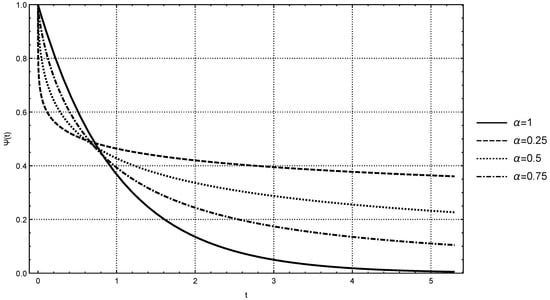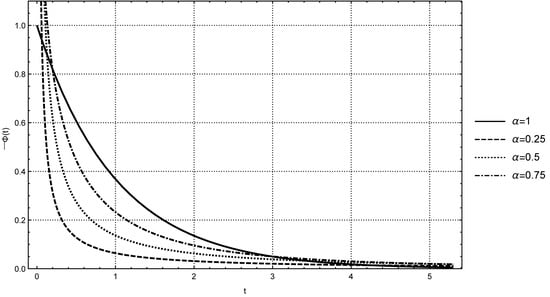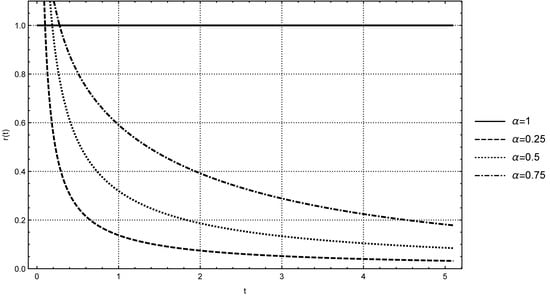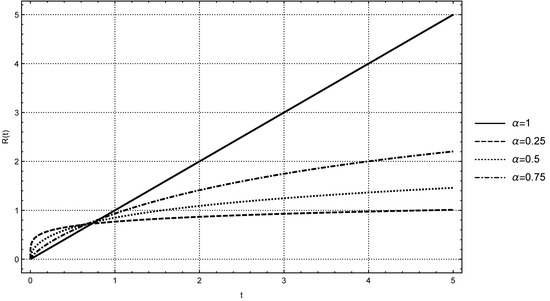Abstract
In this note, we show how an initial value problem for a relaxation process governed by a differential equation of a non-integer order with a constant coefficient may be equivalent to that of a differential equation of the first order with a varying coefficient. This equivalence is shown for the simple fractional relaxation equation that points out the relevance of the Mittag–Leffler function in fractional calculus. This simple argument may lead to the equivalence of more general processes governed by evolution equations of fractional order with constant coefficients to processes governed by differential equations of integer order but with varying coefficients. Our main motivation is to solicit the researchers to extend this approach to other areas of applied science in order to have a deeper knowledge of certain phenomena, both deterministic and stochastic ones, investigated nowadays with the techniques of the fractional calculus.
MSC:
26A33; 33E12; 34A08; 34C26
1. Introduction
Let us consider the following relaxation equation
subjected to the initial condition, for the sake of simplicity,
where and are positive functions, sufficiently well-behaved for . In Equation (1), denotes a non-dimensional field variable and the varying relaxation coefficient.
The solution of the above initial value problem reads
It is easy to recognize from re-arranging Equation (1) that, for
The solution (3) can be derived by solving the initial value problem by separation of variables
>From Equation (3), we also note that
As a matter of fact, we have shown well-known results that will be relevant for the next sections.
2. Mittag–Leffler Function as a Solution of the Fractional Relaxation Process
Let us now consider the following initial value problem for the so-called fractional relaxation process
with . Above, we have labeled the field variable with to point out its dependence on and considered the Caputo fractional derivative, defined as:
As found in many treatises of fractional calculus, and, in particular, in the 2007 survey paper by Mainardi and Gorenflo [1] to which the interested reader is referred for details and additional references, the solution of the fractional relaxation problem (7) can be obtained by using the technique of the Laplace transform in terms of the Mittag–Leffler function. Indeed, we get in an obvious notation by applying the Laplace transform to Equation (7)
so that
For more details on the Mittag–Leffler function, we refer to the recent treatise by Gorenflo et al. [2]. In Figure 1, for readers’ convenience, we report the plots of the solution (10) for some values of the parameter .

Figure 1.
Plots of the Mittag–Leffler function for versus .
It can be noticed that, for , the solution of the initial value problem reduces to the exponential function with a singular limit for because of the asymptotic representation for ,
Now, it is time to carry out the comparison between the two initial value problems described by Equations (1) and (7) with their corresponding solutions (3), (10). It is clear that we must consider the derivative of the Mittag–Leffler function in (10), namely
In Figure 2, we show the plots of positive function for some values of .

Figure 2.
Plots of the positive function for versus .
The above discussion leads to the varying relaxation coefficient of the equivalent ordinary relaxation process:
Figure 3 depicts the plots of for some rational values of , including the standard case , in which the ratio reduces to the constant 1.

Figure 3.
Plots of the ratio for versus .
We conclude by plotting in Figure 4 the function for some values of the parameter .

Figure 4.
Plots of for versus .
3. Conclusions
In this note, we have shown how the fractional relaxation process governed by a fractional differential equation with a constant coefficient is equivalent to a relaxation process governed by an ordinary differential equation with a varying coefficient. These considerations provide a different look at this fractional process over all for experimentalists who can measure the varying relaxation coefficient versus time. Indeed, if this coefficient is found to fit the analytical or asymptotical expressions in Label (13), the researcher cannot distinguish if the governing equation is fractional or simply ordinary. To make the difference, we thus need other experimental results.
We are convinced that it is possible to adapt the above reasoning to other fractional processes, including anomalous relaxation in viscoelastic and dielectric media and anomalous diffusion in complex systems. This extension is left to perceptive readers who can explore these possibilities.
Last but not least, we do not claim to be original in using the above analogy in view of the great simplicity of the argument: for example, a similar procedure has recently been used by Sandev et al. [3] in dealing with the fractional Schrödinger equation.
Acknowledgments
The author is very grateful to Leonardo Benini, a Master’s student in Physics (University of Bologna), for his valuable help in plotting. As a matter of fact, he has used the MATLAB routine for the Mittag–Leffler function appointed by Roberto Garrappa (see https://it.mathworks.com/matlabcentral/fileexchange/48154-the-mittag-leffler-function). The author would like to devote this note to the memory of the late Rudolf Gorenflo (1930–2017), with whom for 20 years he had published joint papers. The author presumes that this note is written in the spirit of Gorenflo, being based on the simpler considerations. This work has been carried out in the framework of the activities of the National Group of Mathematical Physics (GNFM-INdAM). Furthermore, the author has appreciated constructive remarks and suggestions of the anonymous referees that helped to improve this note.
Conflicts of Interest
The author declares no conflict of interest.
References
- Mainardi, F.; Gorenflo, R. Time-fractional derivatives in relaxation processes: A tutorial survey. Fract. Calc. Appl. Anal. 2007, 10, 269–308. [Google Scholar]
- Gorenflo, R.; Kilbas, A.A.; Mainardi, F.; Rogosin, S. Mittag–Leffler Functions, Related Topics and Applications; Springer: Berlin/Heidelberg, Germany, 2014. [Google Scholar]
- Sandev, T.; Petreska, I.; Lenzi, E.K. Effective potential from the generalized time-dependent Schrödinger equation. Mathematics 2016, 4, 59. [Google Scholar] [CrossRef]
© 2018 by the author. Licensee MDPI, Basel, Switzerland. This article is an open access article distributed under the terms and conditions of the Creative Commons Attribution (CC BY) license (http://creativecommons.org/licenses/by/4.0/).